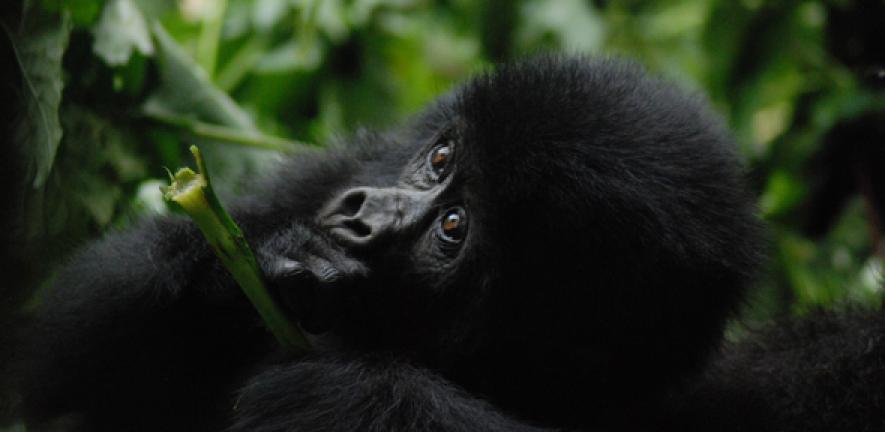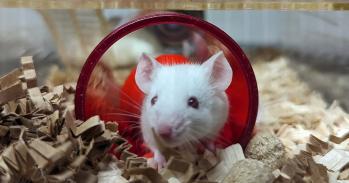
An international research project to sequence whole genomes from mountain gorillas has given scientists and conservationists new insight into the impact of population decline on these critically endangered apes. While mountain gorillas are extensively inbred and at risk of extinction, research published today in Science finds more to be optimistic about in their genomes than expected.
An international research project to sequence whole genomes from mountain gorillas has given scientists and conservationists new insight into the impact of population decline on these critically endangered apes. While mountain gorillas are extensively inbred and at risk of extinction, research published today in Science finds more to be optimistic about in their genomes than expected.
This new understanding of genetic diversity and demographic history among gorilla populations provides us with valuable insight into how apes and humans, their closely related cousins, adapt genetically to living in small populations
Aylwyn Scally
“Mountain gorillas are among the most intensively studied primates in the wild, but this is the first in-depth, whole-genome analysis,” says Dr Chris Tyler-Smith from the Wellcome Trust Sanger Institute. “Three years on from sequencing the gorilla reference genome, we can now compare the genomes of all gorilla populations, including the critically endangered mountain gorilla, and begin to understand their similarities and differences, and the genetic impact of inbreeding.”
The number of mountain gorillas living in the Virunga volcanic mountain range on the borders of Rwanda, Uganda and the Democratic Republic of Congo plummeted to approximately 253 in 1981 as a result of habitat destruction and hunting. Since then, conservation efforts led by the Rwanda Development Board and conservation organizations such as the Gorilla Doctors, and supported by tourists keen to see the gorillas, have bolstered numbers to approximately 480 among the Virunga population.
Researchers interested to learn how such a small gene pool would affect the mountain gorillas were surprised to find that many harmful genetic variations had been removed from the population through inbreeding, and that mountain gorillas are genetically adapting to surviving in small populations.
“This new understanding of genetic diversity and demographic history among gorilla populations provides us with valuable insight into how apes and humans, their closely related cousins, adapt genetically to living in small populations,” says Dr Aylwyn Scally, from the Department of Genetics at the University of Cambridge. “In these data we can observe the process by which genomes are purged of severely deleterious mutations by a small population size.”
Using blood samples collected over several years by the Rwanda Development Board, The Institut Congolese pour la Conservation du Nature and by Gorilla Doctors, which treats wild gorillas injured by snares, researchers were able to sequence the whole genomes of seven mountain gorillas for the first time. Previously, only easily obtainable but poor-quality DNA from faecal and hair samples have been analysed at a handful of regions of the genome.
Scientists discovered that these mountain gorillas, along with eastern lowland gorillas, their closely related neighbours, were two to three times less genetically diverse than gorillas from larger groups in western regions of central Africa. While there are concerns that this low level of genetic diversity may make the mountain gorillas more vulnerable to environmental change and to disease, including cross-infectious strains of human viruses, the inbreeding has, in some ways, been genetically beneficial. Fewer harmful ‘loss-of-function’ variants were found in the mountain gorilla population than in the more numerous western gorilla populations: these variants stop genes from working and can cause serious, often fatal, health conditions.
By analysing the variations in each genome, the researchers also discovered that mountain gorillas have survived in small numbers for thousands of years. Using recently-developed methods, the researchers were able to determine how the size of the population has changed over the past million years. According to their calculations, the average population of mountain gorillas has numbered in the hundreds for many thousands of years; far longer than previously thought.
“We worried that the dramatic decline in the 1980s would be catastrophic for mountain gorillas in the long term, but our genetic analyses suggest that gorillas have been coping with small population sizes for thousands of years,” says Dr Yali Xue from the Sanger Institute. “While comparable levels of inbreeding contributed to the extinction of our relatives the Neanderthals, mountain gorillas may be more resilient. There is no reason why they should not flourish for thousands of years to come.”
It is hoped that the detailed, whole-genome sequence data gathered through this research will aid conservation efforts. Now that a genome-wide map of genetic differences between populations is available, it will be possible to identify the origins of gorillas that have been illegally captured or killed. This will enable more gorillas to be returned to the wild and will make it easier to bring prosecutions against those who poach gorillas for souvenirs and bush meat.
Support for the research came from organisations including the Royal Society, the Wellcome Trust and the National Institutes of Health.
Reference
Xue Y, Prado-Martinez J, Sudmant PH, et al. (2015). Mountain gorilla genomes reveal the impact of long-term population decline and inbreeding. Science. 9 April 2015

The text in this work is licensed under a Creative Commons Attribution 4.0 International License. For image use please see separate credits above.




